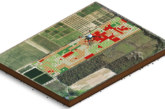 Highlights:
Highlights:
- Leading edge solutions built around Globalstar IoT satellite technology are helping conservationists in Africa to monitor and protect near-extinct rhinoceros from poachers
- Low-cost ST100 chipset is at the heart of wildlife tracking platform provided by specialist Globalstar Value Added Reseller Wintec Solutions
- Satellite technology means tracking of free-roaming animals is ubiquitous and transmissions uninterrupted, even when beyond GSM mobile networks’ reach
Globalstar Europe Satellite Services Ltd., a wholly owned subsidiary of Globalstar, Inc., the next-generation international telecommunications infrastructure and technology provider, announced today that its IoT (internet of things) satellite technology is being used to protect multiple endangered species of wildlife in Africa.
Leading-edge satellite-enabled tracking devices incorporating Globalstar’s small and lightweight ST100 chipset are being used to monitor rhinoceros, part of a widespread concerted effort to protect these nearly-extinct wild animals from illegal poachers.
This is the most recent project carried out by Globalstar Value Added Reseller, Johannesburg-based Wintec Solutions, a specialist technology and solutions provider with extensive experience in animal tracking for wildlife conservation.
Rhinoceros are the subject of widespread illegal killing by poachers across Africa. Wintec Solutions deployed GSatSolar™, the latest addition to Globalstar’s IoT satellite tracking solutions portfolio. GSatSolar is an innovative Sun-powered tracking device built around Globalstar’s economical ST100 satellite IoT transmitter. Low-cost and simple to integrate, GSatSolar is a small and rugged satellite IoT tracker ideal for wildlife monitoring. Rhinos are fitted with the device via ear tagging or collar. Other novel ways of deploying the devices are also being explored. The device is also suitable for livestock tracking.
Nature reserves in Africa are expansive, spanning as many as 20,000 hectares in remote bush regions. Their perimeter fencing is often breached by criminals and poachers attempting to gain access to, and kill, the animals within. Such reserves, which are home to as many as 200 free-ranging rhinos, typically are established in locations where GSM mobile signal does not exist. Only satellite communications can provide the always-on connectivity to enable uninterrupted monitoring of the animals.
Significant advantages of GSatSolar are its small size and light weight, so as not to irritate the animal, as well as its robust structure. Furthermore, its low cost makes the solution easily scalable for tracking large herds of wildlife and farm stock. “Its physical attributes make GSatSolar a game changer, and transform the possibilities for wildlife conservation and livestock management,” says Rene Winter, Director of Wintec Solutions.
Globalstar-enabled solutions are at the forefront of today’s conservation activities in Africa; Wintec Solutions is additionally playing a role in the preservation of other African species. Researchers at Giraffe Conservation Foundation are using the system to monitor giraffe migration, and for keeping safeguarding tabs on animals which have been reintroduced into the wild. “We are currently trialling GSatSolar ear tags on giraffe in Namibia. The first units were deployed in June this year and, while field trials are still ongoing, the data received so far are very promising. We’re looking forward to deploying more units in the future and testing them in different countries,” said Dr Courtney Marneweck, Science Data Coordinator at Giraffe Conservation Foundation.
Wintec Solutions is also deploying satellite technology and Globalstar-enabled animal tags in collaboration with veterinary authorities and research students for wild buffalo protection activities in South Africa’s Kruger National Park. Buffalo migration is being monitored so conservationists and government authorities can understand and mitigate the potential spread of Bovine Tuberculosis. In another project, the application of Globalstar-enabled trackers is being tested on pangolins, yet another severely endangered species.
The tracking platform UI developed Wintec Solutions includes an informative mapping portal that tracks the animals’ individual and group movements. Monitoring the rhino, or other wildlife, also informs as to grazing habits, locations of the best nutrition, seasonal breeding habits, as well as the animals’ general health and well-being.
Winter said:
“Our wildlife preservation activities take place well beyond the reach of GSM mobile; Globalstar’s satellite network, with its ubiquitous reach and reliability, is a fundamental enabler in the operations being carried out to protect endangered species.”
“Globalstar created the ST100 transmitter to meet the widespread need for easy-to-integrate, low-cost and lightweight monitoring devices that leverage satellite technology and the Internet of Things,” commented Mark O’Connell, General Manager at Globalstar EMEA & APAC. “We are absolutely delighted that solutions developed through the inventiveness and commitment of our partner Wintec Solutions are now playing such a pivotal role in the vital wildlife conservation activities today taking place across Africa,” he added.







